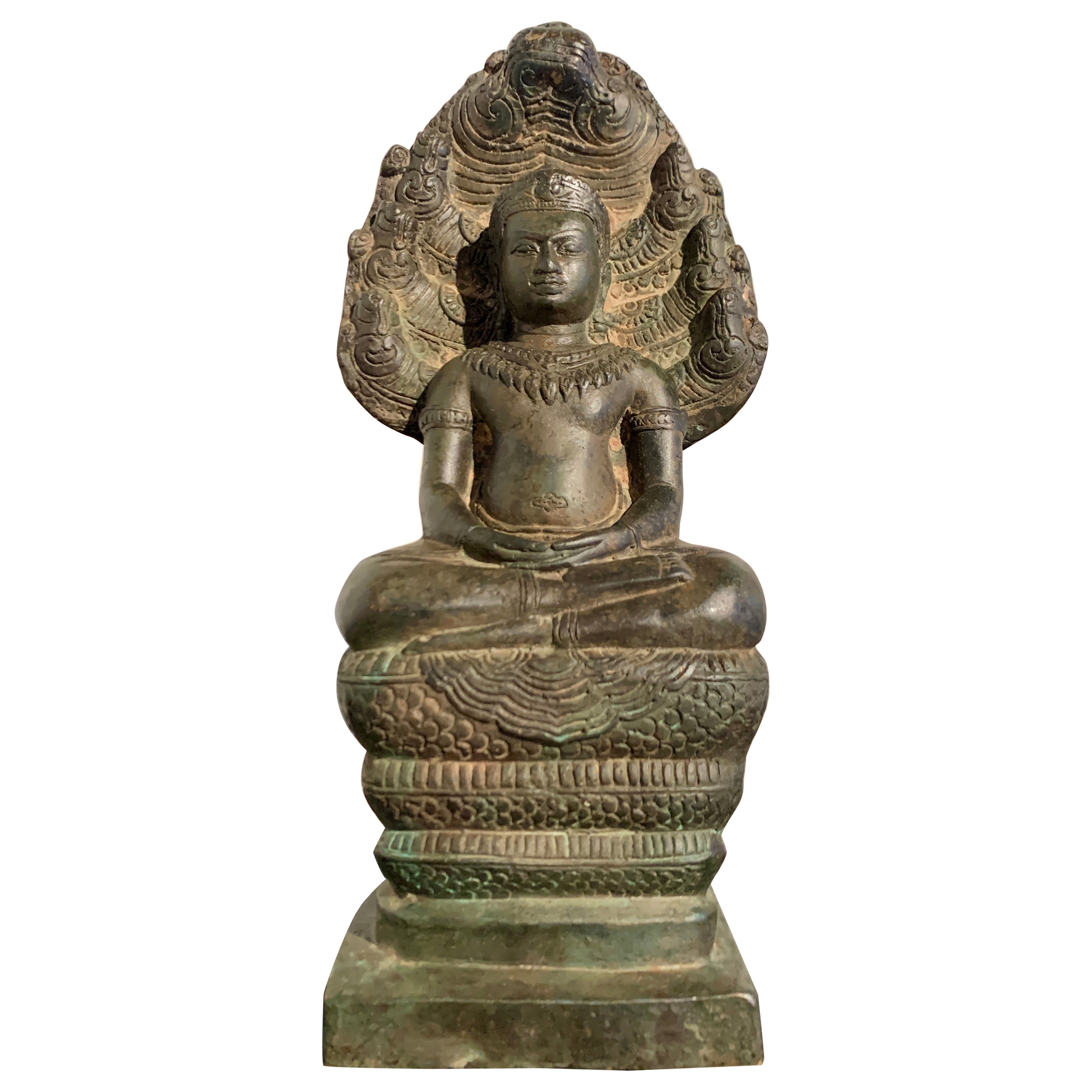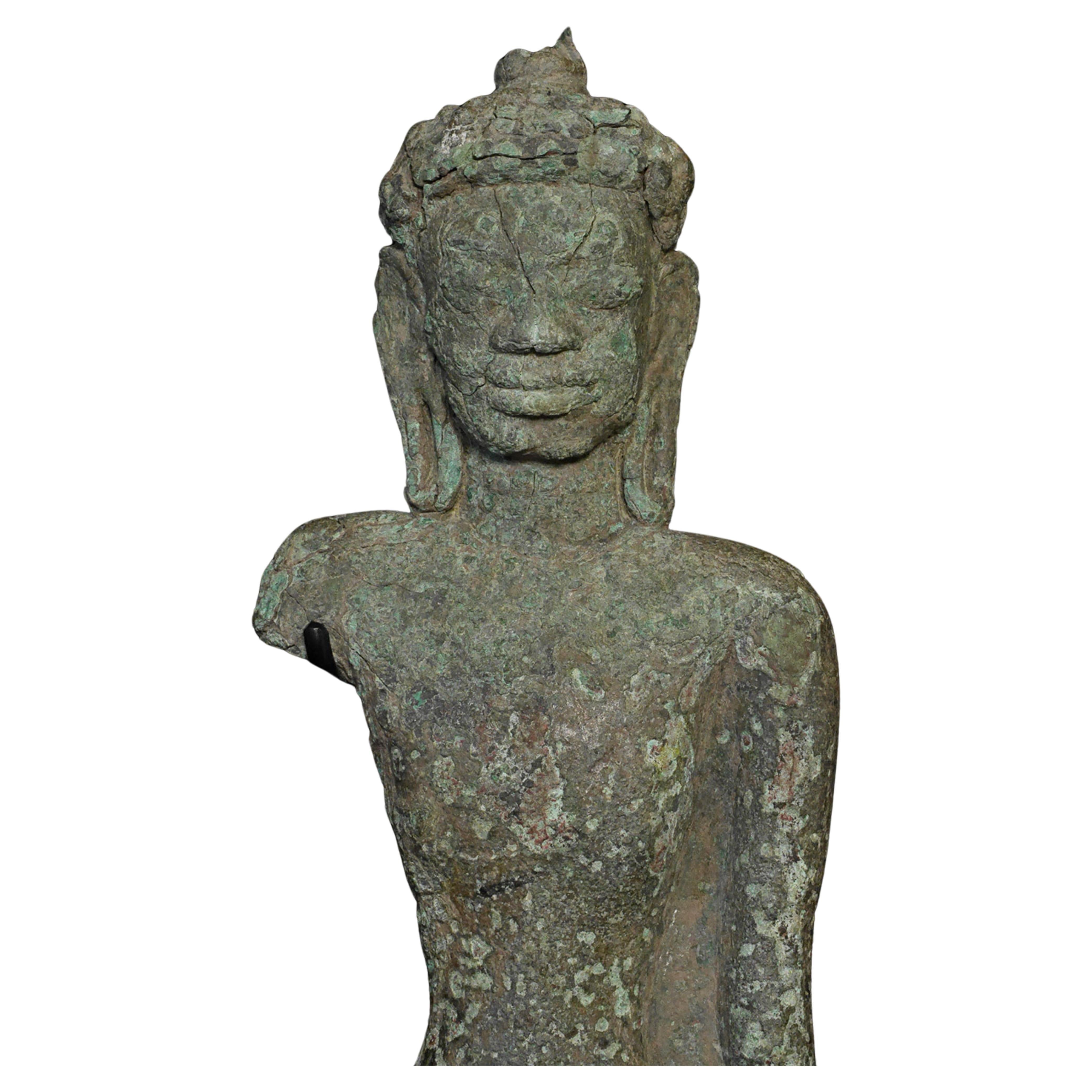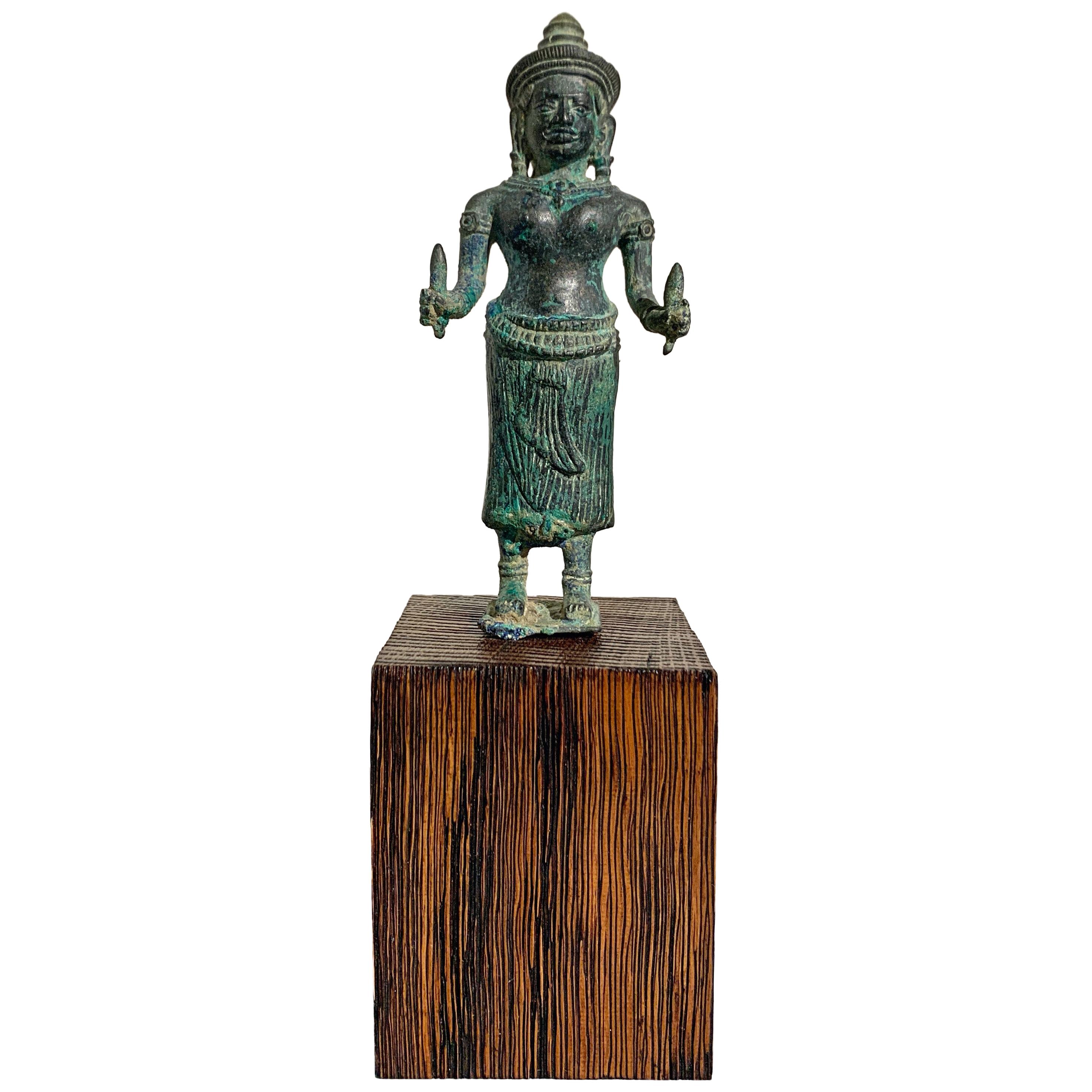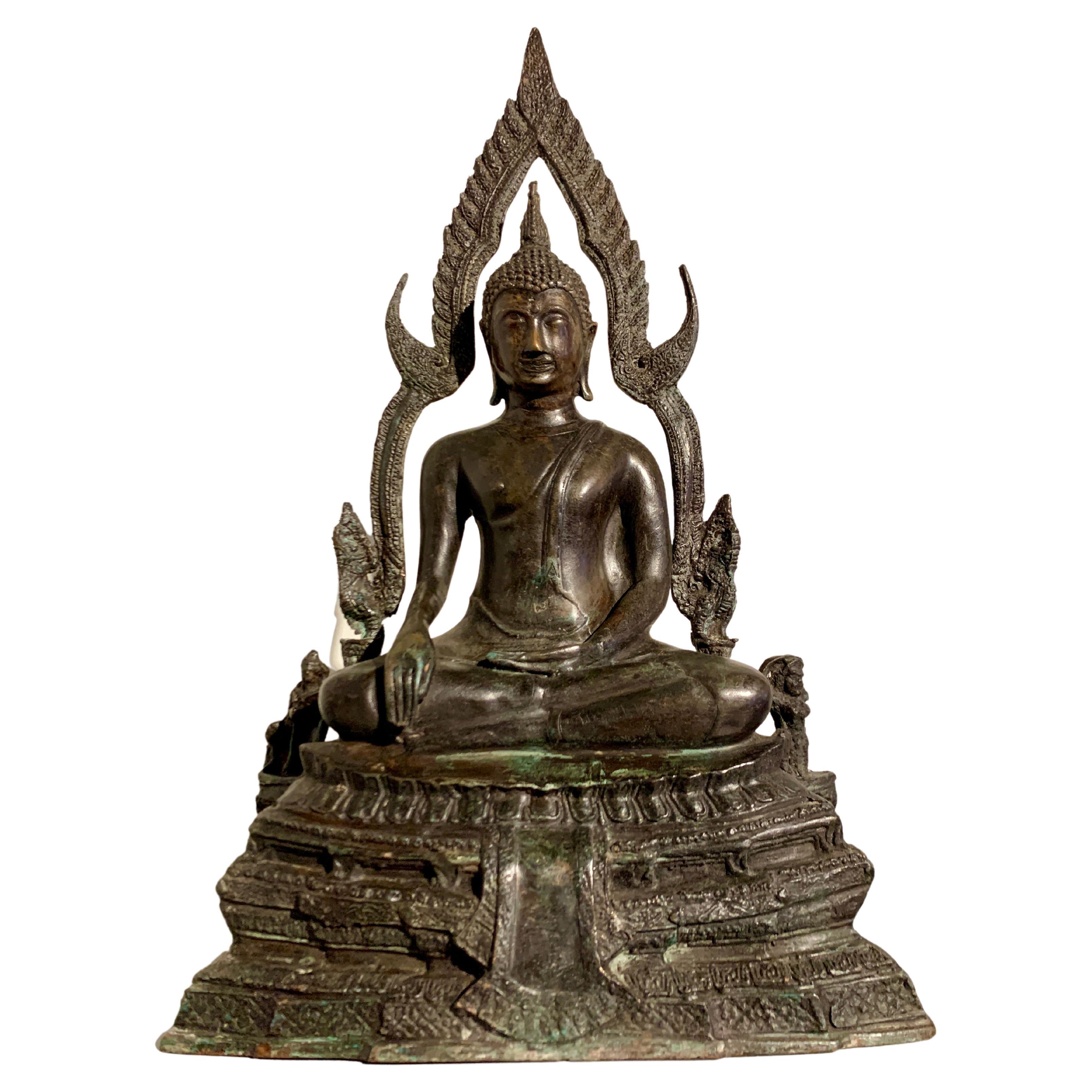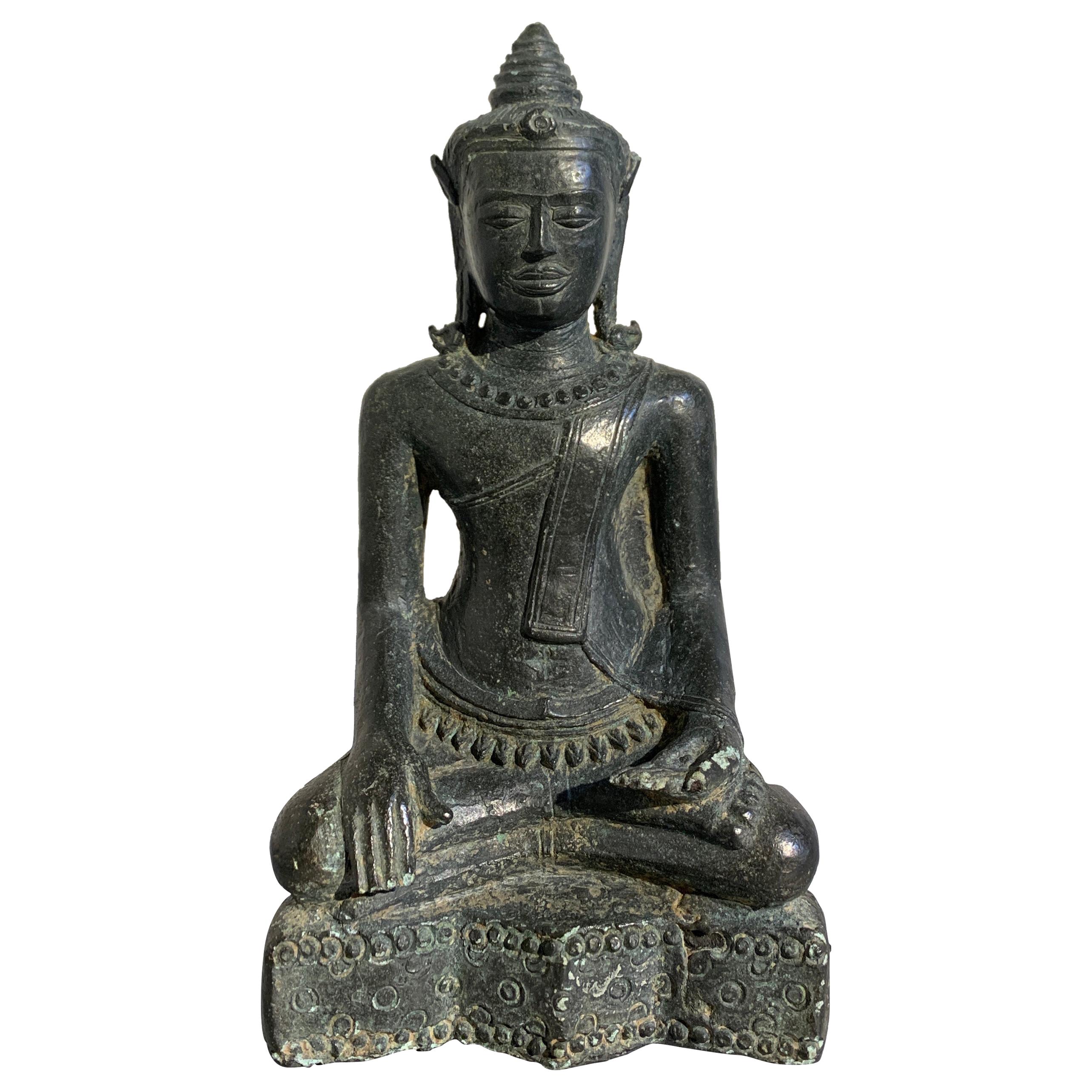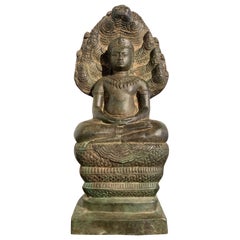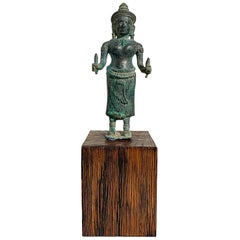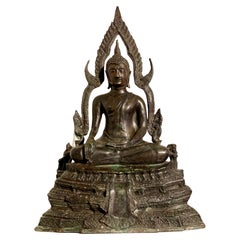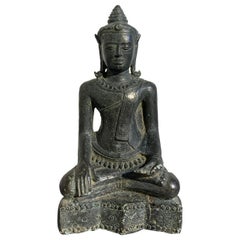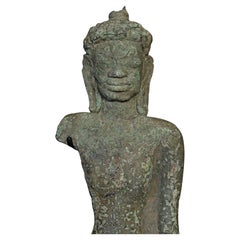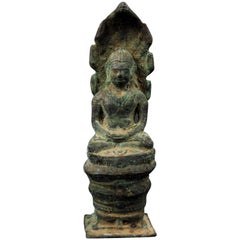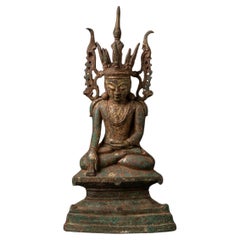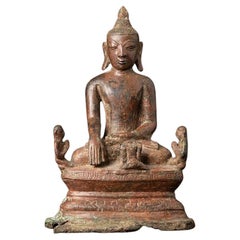Items Similar to Khmer Bronze Buddhist Triad, Style of the Bayon, 12th-13th Century, Cambodia
Want more images or videos?
Request additional images or videos from the seller
1 of 20
Khmer Bronze Buddhist Triad, Style of the Bayon, 12th-13th Century, Cambodia
$58,000
£44,040.77
€50,363.91
CA$81,034.41
A$90,127.95
CHF 47,062.02
MX$1,096,761.32
NOK 601,053.77
SEK 563,682.40
DKK 375,885.19
Shipping
Retrieving quote...The 1stDibs Promise:
Authenticity Guarantee,
Money-Back Guarantee,
24-Hour Cancellation
About the Item
An important Khmer bronze Buddhist triad group featuring an image of the Buddha sheltered by a naga, and flanked by the bodhisattvas Avalokiteshvara and Prajnaparamita, Angkor Period, Style of the Bayon, late 12th-early 13th century, Cambodia.
This triad represents one of the most important images in Khmer art. The iconography was developed under the rule of King Jayavarman VII (ruled c. 1181 to c. 1218), with the imagery becoming the personal icon of the renowned king.
On the surface, this image represents the Buddha sheltered by the Naga King Muchalinda, the seven headed serpent, and flanked by two of the most important bodhisattvas in the Buddhist pantheon, Avalokiteshvara, the Bodhisattva of Compassion, and Prajnaparamita, the Bodhisattva of Transcendent Wisdom, also known as the Mother of All Buddhas.
On another level, this image is meant to represent the royal family in the guise of enlightened beings, with King Jayavarman VII as the Buddha, his father as Avalokiteshvara, and his mother as Prajnaparamita. This image further solidified the idea of the God King, or the divine right to rule. The crown upon the Buddha's head, and the rich jewelry that adorns him reinforces this ideology.
The image of the Buddha sheltered by a Naga, also known as Buddha Muchalinda, is an important image in Khmer art. Legend states that shortly after the Buddha reached enlightenment, he began a deep meditation. During his meditation, a large storm blew in. Fearing the Buddha's meditation would be interrupted by the malevolent storm, Muchalinda, King of the Nagas, raised the Buddha upon his coils and sheltered him with his seven hooded heads until the storm passed. The image conveys the protection Buddhist practitioners hope to obtain from the teachings of the Buddha.
Avalokiteshvara, the Bodhisattva of Compassion, is portrayed in his four armed form, representing his active nature. He is dressed in the regalia of royalty, with a crown upon his head, a large necklace, armlets and bracelets adorning his body. He wears a pleated sampot embellished with a jeweled belt. An image of Amitabha Buddha graces his crown.
Prajnaparamita, the Bodhisattva of Transcendent Wisdom, is portrayed as a matronly figure, bare chested, and adorned similarly to her counterpart, Avalokiteshvara, with a crown, and festooned with jewels. She holds a lotus bud in one hand, a sutra in the other.
The figures were cast separately then attached to the rectangular tiered plinth.
Provenance:
Dorris Weiner, 1980s
Dr. Charles Smithen Collection, 1990s.
- Dimensions:Height: 9 in (22.86 cm)Width: 7 in (17.78 cm)Depth: 1.5 in (3.81 cm)
- Materials and Techniques:Bronze,Cast
- Place of Origin:
- Period:
- Date of Manufacture:circa 1200
- Condition:Repaired: Repair of the top of the naga. The repair most noticeable at the back. One or two arms of Avalokiteshvara possibly repaired. Wear consistent with age and use. Minor structural damages. The top of the naga repaired. Small loss to the fishtail of the sampot. One or two arms of Avalokiteshvara possibly repaired. The bronze cleaned.
- Seller Location:Austin, TX
- Reference Number:1stDibs: LU894716285311
About the Seller
5.0
Platinum Seller
Premium sellers with a 4.7+ rating and 24-hour response times
Established in 2001
1stDibs seller since 2010
345 sales on 1stDibs
Typical response time: <1 hour
- ShippingRetrieving quote...Shipping from: Austin, TX
- Return Policy
Authenticity Guarantee
In the unlikely event there’s an issue with an item’s authenticity, contact us within 1 year for a full refund. DetailsMoney-Back Guarantee
If your item is not as described, is damaged in transit, or does not arrive, contact us within 7 days for a full refund. Details24-Hour Cancellation
You have a 24-hour grace period in which to reconsider your purchase, with no questions asked.Vetted Professional Sellers
Our world-class sellers must adhere to strict standards for service and quality, maintaining the integrity of our listings.Price-Match Guarantee
If you find that a seller listed the same item for a lower price elsewhere, we’ll match it.Trusted Global Delivery
Our best-in-class carrier network provides specialized shipping options worldwide, including custom delivery.More From This Seller
View AllKhmer Cast Bronze Buddha Sheltered by Naga, 19th Century, Cambodia
Located in Austin, TX
A well cast Khmer style bronze figure of an adorned Buddha sheltered by a Naga, Buddha Muchalinda, 19th century or earlier, Cambodia.
The sculpture in th...
Category
Antique 19th Century Cambodian Sculptures and Carvings
Materials
Bronze
Khmer Bronze Uma, Angkor Wat Style, 12th Century, Cambodia
Located in Austin, TX
A small Khmer bronze figure of the Hindu goddess Uma, Angkor Period, Style of Angkor Wat, circa 12th century, Cambodia.
This small Khmer bronze devotiona...
Category
Antique 15th Century and Earlier Cambodian Sculptures and Carvings
Materials
Bronze
Thai Bronze Buddha, Phra Phuttha Chinnarat, Early 20th century, Thailand
Located in Austin, TX
A well cast smaller scale bronze reproduction of the famous golden Buddha known as Para Puttha Chinnarat, housed at Wat Phra Si Rattana Mahathat, mid 20th century, Thailand.
A faith...
Category
Vintage 1920s Thai Sculptures and Carvings
Materials
Bronze
Thai Lopburi Cast Bronze Seated Buddha, 13th Century
Located in Austin, TX
A fine early Thai Lopburi figure of a crowned and adorned Buddha, cast bronze, mid-13th century.
The unusual figure of the Buddha sits in virasana upon a stylized lotus pedestal. He is dressed in the traditional monastic robes, but also adorned with a crown and jewelry, including earrings, a necklace, and jeweled belt.
His hands in an atypical combination of mudras. His right hand in bhumisparsha mudra, reaching down to touch the earth, while his left hand held somewhat outwards, seemingly in varada mudra, the gesture of granting favours or wishes. The palm of his outstretched hand marked with the dharmachakra, the Wheel of the Law, representing Buddhist teaching.
The bronze with a beautiful silvery patina.
Lopburi was an independent Mon kingdom with strong ties to the Khmer Angkor...
Category
Antique 15th Century and Earlier Thai Sculptures and Carvings
Materials
Bronze
Khmer Bronze Figure of Prajnaparamita with Eleven Faces
Located in Austin, TX
The embodiment of transcendental wisdom, Prajnaparamita is often referred to as the mother of all Buddhas.
In this extremely rare tantric form, she is portrayed seated in the half lotus position. Her eleven faces are arranged in two tiers (seven on the first, with an additional four above), all surmounted by a rising conical chignon. Each face has an associated pair of arms which radiate outwards, each hand holding a discreet attribute.
Careful attention has been paid to her clothing and jewelry. She wears a heavily pleated sampot with a cross hatch pattern, elegantly turned down at the waist and tied with an ornate belt...
Category
Antique 18th Century and Earlier Cambodian Sculptures
Materials
Bronze
Small Thai Seated Bronze Buddha Maravijaya, Ayutthaya, 16th Century
Located in Austin, TX
A small Thai cast seated bronze figure of the historical Buddha Shakyamuni, Northern Thailand, Ayutthaya period, 16th century.
This sculpture captures the m...
Category
Antique 16th Century Thai Tribal Sculptures and Carvings
Materials
Bronze
You May Also Like
5-7thC Thai Mon Buddha- Of the Earliest S.E.Asian Bronze Buddha Types-Very Large
Located in Ukiah, CA
Very early SE Asian Mon Buddha--probably 6thC. Extremely rare to find in such a large size (the full figure would have stood a good 18+ inches tall, which w...
Category
Antique 15th Century and Earlier Thai Antiquities
Materials
Bronze
Khmer Buddha Naga Art, Bronze, Angkor Period, 12 Century
Located in Beuzevillette, FR
Bronze Buddha wearing the monastic garment. It sits on the coiled naga whose body forms the three spirals. The seven heads of the serpent form a canopy to protect Buddha during medit...
Category
Antique 15th Century and Earlier Cambodian Sculptures and Carvings
Materials
Bronze
15-16th century Very special antique bronze Burmese Buddha statue from Burma
Located in DEVENTER, NL
Very special antique bronze Burmese Buddha statue
Material : bronze
36,8 cm high
18 cm wide and 10,5 cm deep
With traces of the original lacquer and 24 krt. gilding
Ava style
Bhumisp...
Category
Antique 15th Century and Earlier Burmese Sculptures and Carvings
Materials
Bronze
Very early antique bronze Burmese Buddha statue from Burma
Located in DEVENTER, NL
Material: bronze
22,4 cm high
14,5 cm wide and 8 cm deep
Weight: 1.242 kgs
Ava style
Bhumisparsha mudra
Originating from Burma
15th century - early Ava period
Very rare !
Category
Antique 15th Century and Earlier Burmese Sculptures and Carvings
Materials
Bronze
16th century antique bronze Thai Buddha statue from Burma
Located in DEVENTER, NL
The antique bronze Thai Buddha statue is a captivating and historically significant artifact. Crafted from bronze and bearing traces of 24-karat gold gilding, this statue stands at 2...
Category
Antique 16th Century Thai Sculptures and Carvings
Materials
Bronze
Antique Bronze Thai Rattanakosin Buddha from Thailand
Located in DEVENTER, NL
Material: bronze
29,9 cm high
22,7 cm wide and 12,5 cm deep
Weight: 4.669 kgs
Gilded with 24 krt. gold
Bhumisparsha mudra
Originating from Thailand
19th century, Rattanakosin...
Category
Antique 19th Century Thai Sculptures and Carvings
Materials
Bronze
